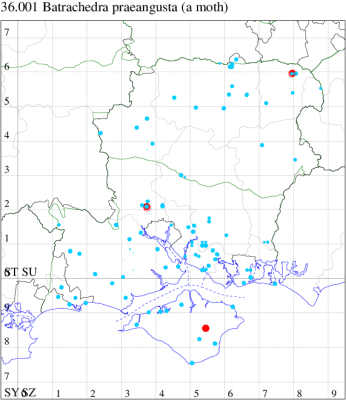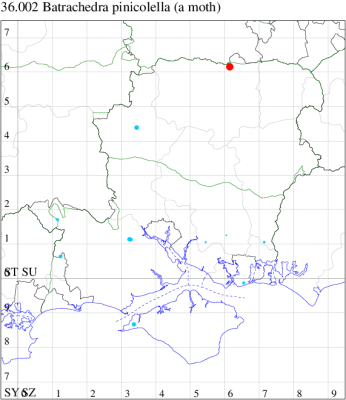2020 Annual Report for: Batrachedridae / Batrachedrinae
For species seen in 2020 that had less than or equal to 100 records, full details are included; for more common species, the earliest, latest and highest count by vice-county are shown. The narrative for each species is taken from the main Hantsmoths website, and it is possible that some information on abundance and occurrence can get out of date, as it is impossible to keep up with all changes; however it should give a good introduction to each species. The tables in each species account summarise the previous status, and that for the current year.
For the maps, all records prior to 2020 are shown by a blue dot (the larger the dot, the more recent), with the current year's records shown in red. As previous records are superimposed on any report for 2020, new sites have greater emphasis (i.e. will show as 'more red').
In the species accounts, an asterisk next to a location indicates a new 10km square record; earliest ever dates are highlighted in orange, and latest ever in red. Initials in the species accounts refer to the recorders listed here. Please get in touch if you identify any omissions or errors, in particular if you have records that have yet to be submitted. Details of how to submit records can be found here.
36.001 [B&F: 0878] Batrachedra praeangusta (Haworth, 1828) - Common
Common wherever the foodplant occurs in a wide range of habitats throughout the British Isles, north to Aberdeenshire. In Hampshire recorded principally from the south-east, and in the New Forest, with scattered records elsewhere. Not recorded from the Isle of Wight to date. Wingspan 14-15 mm. Larva feeds on catkins and seeds of White Poplar, Aspen, White Willow and Goat Willow.
Records prior to 2020
| Vice County | #Records | #Individuals | First Record | Last Record |
|---|---|---|---|---|
| 10 | 16 | 17 | 2011 | 2019 |
| 11 | 144 | 143 | 1973 | 2019 |
| 12 | 44 | 52 | 1975 | 2019 |
2020 records
| Vice County | #Records | #Individuals | Max Quantity |
|---|---|---|---|
| 10 | 1 | 1 | 1 |
| 11 | 1 | 1 | 1 |

Records by year
Records by week (adult)
Records by week (larval)
Record Details
VC10: Haseley Manor, one, 11 Aug (IOu);
VC11: Romsey, one, 23 Jun (MB); Eastleigh, one, to actinic, 07 Aug (KArb);
VC12: Castle Bottom NNR, two, 25 Jun (JHH, AMD)
36.002 [B&F: 0879] Batrachedra pinicolella (Zeller, 1839) - Nationally Scarce B
Hall and Plant wrote in Ent Rec 134(2) April 2022, following Berggren et al, 2022 in ZooKeys 1085 that B. pinicolella should be split into two species, with B. confusella being new to science. The two can only be reliably identified by dissection. The present species appears to be rare, but this is based on only a very limited data set to date.
B. pinicolella appears restricted to Norway Spruce, with confusella having a wider range of pabula, on various Pinus species and Larix. As such it can be expected that most, if not all, Hampshire and Isle of Wight records refer to the latter.
Given the above, there are at present no confirmed records of pinicolella for our area. The mapped distribution refers to what for now must be considered to be pinicolella/confusella agg.
Records prior to 2020
| Vice County | #Records | #Individuals | First Record | Last Record |
|---|---|---|---|---|
| 10 | 1 | 1 | 2013 | 2013 |
| 11 | 26 | 32 | 1982 | 2014 |
| 12 | 1 | 1 | 2017 | 2017 |
2020 records
| Vice County | #Records | #Individuals | Max Quantity |
|---|---|---|---|
| 12 | 1 | 2 | 2 |

Records by year
Records by week (adult)
Records by week (larval)
Record Details
VC12: Pamber Forest*, two, 25 Jun (GJD)